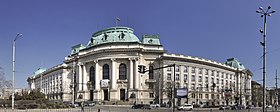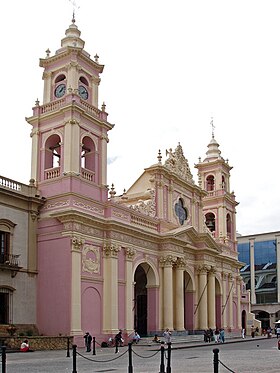Baroque Revival architecture

Belfast City Hall, an example of Edwardian Baroque architecture or "Wrenaissance"

The Széchenyi Medicinal Bath in Budapest

Alferaki Palace in Taganrog, Russia (1848)

Sofia University rectorate in Sofia (1924-1934)

Church of Salta, Argentina
The Baroque Revival, also known as Neo-Baroque (or Second Empire architecture in France), was an architectural style of the late 19th century.[1] The term is used to describe architecture which displays important aspects of Baroque style, but is not of the Baroque period proper—i.e., the 17th and 18th centuries. Elements of the Baroque architectural tradition were an essential part of the curriculum of the École des Beaux-Arts in Paris, the pre-eminent school of architecture in the second half of the 19th century, and are integral to the Beaux-Arts architecture it engendered both in France and abroad. An ebullient sense of European imperialism encouraged an official architecture to reflect it in Britain and France, and in Germany and Italy the Baroque revival expressed pride in the new power of the unified state.
Contents
1 Notable examples
2 Baroque Revival architects
3 Gallery
4 See also
5 References
Notable examples
Akasaka Palace (1899–1909), Tokyo, Japan
Alferaki Palace (1848), Taganrog, Russia
Ashton Memorial (1907–1909), Lancaster, England
Belfast City Hall (1898–1906), Belfast, Northern Ireland
Beloselsky-Belozersky Palace (1747), Saint Petersburg, Russia
Bode Museum (1904), Berlin, Germany
British Columbia Parliament Buildings (1893–1897), Victoria, British Columbia, Canada
Burgtheater (1888), Vienna, Austria
Christiansborg Palace (1907–1928), Copenhagen, Denmark
Cluj-Napoca National Theatre (1904–1906), Cluj-Napoca, Romania
Ortaköy Mosque (1854–6), Istanbul, Turkey
Dolmabahçe Palace (1843–1856), Istanbul, Turkey
The Elms Mansion (1899–1901), Newport, Rhode Island, United States
National Theatre (1899), Oslo, Norway
Palais Garnier (also known as the Paris Opera) (1861–1875), Paris, France
Rosecliff Mansion (1898–1902), Newport, Rhode Island, United States
Royal Museum for Central Africa (1905–1909), Tervuren, Belgium
Semperoper (1878), Dresden, Germany
Sofia University rectorate (1924–1934), Sofia, Bulgaria
Zachęta National Gallery of Art (1898–1900), Warsaw, Poland
St. Barbara's Church (1910), Brooklyn, New York, United States
St. John Cantius Church (1893–1898), Chicago, United States
Church of St. Ignatius Loyola (1895–1900), New York City, United States
Church of Saints Peter and Paul (1932–39), Athlone, Ireland
Cathedral of Salta (1882), Salta, Argentina
Széchenyi thermal bath (1913), Budapest, Hungary
Volkstheater (1889), Vienna, Austria
National Art Gallery of Bulgaria (the former royal palace), Sofia, Bulgaria- Wenckheim Palace (1886–1889), Budapest, Hungary
- Stefánia Palace (formerly named Park Club) (1893–1895), Budapest, Hungary
Gran Teatro de La Habana (1908–1915), Havana, Cuba
Old Parliament Building (1930), Colombo, Sri Lanka
Altare della Patria (1885–1925), Rome, Italy
House of the National Assembly of Serbia (1907–1936), Belgrade, Serbia.
Durban City Hall, South Africa
There are also number of post-modern buildings with a style that might be called "Baroque", for example the Dancing House in Prague by Vlado Milunić and Frank Gehry, who have described it as "new Baroque".[2]
Baroque Revival architects
Ferdinand Fellner (1847–1917) and Hermann Helmer (1849–1919)
Arthur Meinig (1853–1904)- Sir Edwin Lutyens (1869–1944)
- Members of the Armenian Balyan family (19th Century)
Charles Garnier (1825–1898)
Gallery

Károlyi Palace, Budapest (1881–1883) by Fellner & Helmer

Wenckheim Palace, Budapest (1886–1889) by Arthur Meinig
Zachęta National Art Gallery, Warsaw (1898–1900) by Stefan Szyller
See also
- Baroque
- List of Baroque architecture
- Second Empire architecture
- Beaux-Arts architecture
- Edwardian Baroque architecture
- Wilhelminism
References
| Wikimedia Commons has media related to Neo-Baroque architecture. |
^ "Baroque/Baroque Revival". Buffaloah.com. Retrieved 2012-08-15..mw-parser-output cite.citation{font-style:inherit}.mw-parser-output .citation q{quotes:"""""""'""'"}.mw-parser-output .citation .cs1-lock-free a{background:url("//upload.wikimedia.org/wikipedia/commons/thumb/6/65/Lock-green.svg/9px-Lock-green.svg.png")no-repeat;background-position:right .1em center}.mw-parser-output .citation .cs1-lock-limited a,.mw-parser-output .citation .cs1-lock-registration a{background:url("//upload.wikimedia.org/wikipedia/commons/thumb/d/d6/Lock-gray-alt-2.svg/9px-Lock-gray-alt-2.svg.png")no-repeat;background-position:right .1em center}.mw-parser-output .citation .cs1-lock-subscription a{background:url("//upload.wikimedia.org/wikipedia/commons/thumb/a/aa/Lock-red-alt-2.svg/9px-Lock-red-alt-2.svg.png")no-repeat;background-position:right .1em center}.mw-parser-output .cs1-subscription,.mw-parser-output .cs1-registration{color:#555}.mw-parser-output .cs1-subscription span,.mw-parser-output .cs1-registration span{border-bottom:1px dotted;cursor:help}.mw-parser-output .cs1-ws-icon a{background:url("//upload.wikimedia.org/wikipedia/commons/thumb/4/4c/Wikisource-logo.svg/12px-Wikisource-logo.svg.png")no-repeat;background-position:right .1em center}.mw-parser-output code.cs1-code{color:inherit;background:inherit;border:inherit;padding:inherit}.mw-parser-output .cs1-hidden-error{display:none;font-size:100%}.mw-parser-output .cs1-visible-error{font-size:100%}.mw-parser-output .cs1-maint{display:none;color:#33aa33;margin-left:0.3em}.mw-parser-output .cs1-subscription,.mw-parser-output .cs1-registration,.mw-parser-output .cs1-format{font-size:95%}.mw-parser-output .cs1-kern-left,.mw-parser-output .cs1-kern-wl-left{padding-left:0.2em}.mw-parser-output .cs1-kern-right,.mw-parser-output .cs1-kern-wl-right{padding-right:0.2em}
^ "The Dancing Building, which Frank Gehry and Vlado Milunic have described as "new Baroque", has divided opinion [...]", in "Architect recalls genesis of Dancing Building as coffee table book published", by Ian Willoughby, 11-07-2003, online at The international service of Czech Radio
- James Stevens Curl; "Neo-Baroque." A Dictionary of Architecture and Landscape Architecture; Oxford University Press. 2000. — Encyclopedia.com . accessed 3 Jan. 2010.


